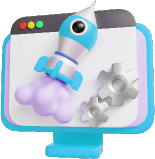
We provide comprehensive migration services and support in the process of migrating to the cloud from:
We have experience in migrating applications from both traditional hosting servers (e.g., OVH, Hetzner) and platforms (e.g., Heroku), as well as migrations between clouds.
Cloud is a modern approach to building and running software applications. Our knowledge about shared platforms (e.g. Heroku), dedicated servers or on-prem solutions allows us to migrate projects effectively to the cloud.
A particular case is the migration process from the Heroku platform to AWS (check out our case study), which involves moving from PaaS (Platform as a Service) to IaaS (Infrastructure as a Service). PaaS typically offers highly specialized environments suitable for projects of specific sizes. As a project grows and develops, architectural limitations and cost increases arise, making long-term migration to more flexible IaaS environments (public clouds) more cost-effective.
So if you have an advanced, complex project, migration to AWS Will give you better scalability and availability of databases. This will support the development of the project instead of limiting it, as Heroku might do.

Pros

Cons
Migrations from the cloud to other environments also occur. Cost is usually the main factor. Many companies use on-premise environments and/or their own hardware because their projects do not require advanced cloud solutions, or the direct costs (CapEx) have already been incurred, and hardware requirements are predictable and consistent.
Successful and secure data migration requires specialized knowledge and multidisciplinary skills. Our team, with extensive experience in various types of migrations, is well acquainted with various architectures and environments. We know what complications to expect and how to prevent them. Undertaking a migration without specialized knowledge, relying solely on general knowledge, poses risks of prolonging the process, increasing costs, and lacking security.
The migration process can take anywhere from a few weeks to several months. Factors that determine the duration include:
The most common time frames are:
up to 3 months, 3-6 months, 6-18 months, 18-24 months, 24 months or more.
1. We prepare a Non-Disclosure Agreement (NDA)
2. We conduct a review of the current state, processes, and client's goals and needs
3. We assist in negotiations with public cloud operators to obtain appropriate support and often funds for initial migration work
4. We plan the work
5. We implement changes
6. We verify the results
7. We proceed with further production deployment
8. We initiate maintenance
1. We prepare a Non-Disclosure Agreement (NDA)
2. We conduct a review of the current state, processes, and client's goals and needs
3. We assist in negotiations with public cloud operators to obtain appropriate support and often funds for initial migration work


6. We verify the results
5. We implement changes
4. We plan the work
7. We proceed with further production deployment
8. We initiate maintenance